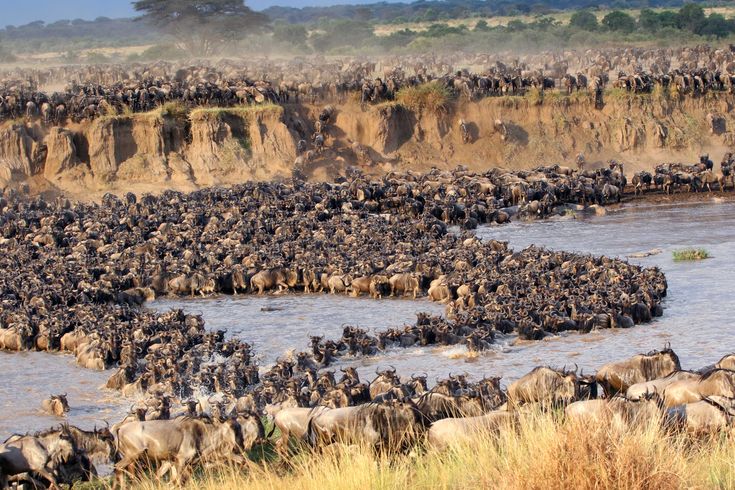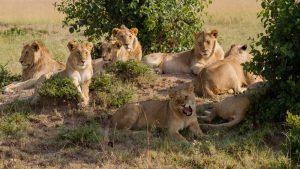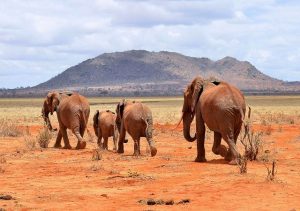What is the annual wildebeest migration?
The annual wildebeest migration is one of the most spectacular natural events on Earth. Over 1.5 million wildebeests, accompanied by zebras and gazelles, move in a circular route across the Serengeti in Tanzania and the Maasai Mara in Kenya. They search for fresh grazing pastures and water, driven by seasonal rainfall patterns. This migration is often called the “Great Migration” because of its scale and the dramatic river crossings that occur along the way. Annual Wildebeest Migration per Month
Where does the wildebeest migration take place?
The wildebeest migration takes place across the Serengeti National Park in Tanzania and the Maasai Mara National Reserve in Kenya. The journey covers approximately 1,800 miles annually, forming a continuous cycle. The herds move through distinct regions at different times of the year, making it possible for travelers to witness this phenomenon in multiple locations depending on the season.
How many wildebeests take part in the migration each year?
Each year, more than 1.5 million wildebeests, joined by 200,000 zebras and 350,000 gazelles, participate in the migration. Predators such as lions, cheetahs, crocodiles, and hyenas closely follow the herds, creating dramatic wildlife interactions that make the migration a world-renowned safari experience.
Why is the wildebeest migration called the “Great Migration”?
The migration earns the title “Great Migration” due to its sheer scale and intensity. Millions of animals move together, forming massive columns that can stretch for kilometers. The iconic river crossings at the Grumeti and Mara Rivers, where herds risk their lives against crocodiles and strong currents, add to its legendary status as one of nature’s greatest spectacles. Annual Wildebeest Migration per Month
The Wildebeest Migration Month by Month
What happens during the wildebeest migration in January?
In January, the wildebeests gather in the southern Serengeti plains, particularly around Ndutu and Ngorongoro Conservation Area. This is the start of the calving season, where thousands of calves are born every day. The abundance of young calves attracts predators like lions and hyenas, creating dramatic wildlife encounters.
Where are the wildebeests in February?
February remains part of the calving season. Over 500,000 calves are born during this period, usually within a span of two to three weeks. The herds stay in the short-grass plains of the southern Serengeti because the area offers rich grazing and safety in numbers against predators.
What stage of the migration occurs in March?
By March, the calving season winds down. The herds continue grazing in the southern plains, but water sources start to decline. The animals prepare for their long journey northward as the rains become less reliable. Predators remain active, targeting vulnerable calves that are still learning to move with the herds.
What happens during April in the wildebeest migration?
April marks the beginning of the mass movement northward. The wildebeests start leaving the southern plains, moving toward the central Serengeti. Heavy rains during this time make the terrain muddy, slowing the herds but providing abundant grazing. The migration spreads out into long columns as the animals advance.
Where do the wildebeests move in May?
In May, the herds gather in the Seronera region of the central Serengeti. This is the peak of the rainy season, and the grass is lush. The animals form large groups, covering vast stretches of land. By the end of May, the herds start moving west toward the Western Corridor, preparing for their first major challenge—the Grumeti River crossing.
What migration events take place in June?
In June, the herds reach the Western Corridor. The Grumeti River stands in their path, and the first river crossings of the migration begin. Unlike the Mara River, the Grumeti has fewer but massive crocodiles. The crossings are dangerous, and many wildebeests do not survive. This period marks the transition into the dry season, forcing the herds to continue north.
Why is July an important month in the wildebeest migration?
July is one of the most critical months of the migration. The herds push north through the Serengeti, reaching the Grumeti–Mara ecosystem. They gather along the northern Serengeti, preparing for the iconic Mara River crossing. This is when travelers often witness dramatic scenes of survival as wildebeests leap into the crocodile-filled waters.
What happens during the Mara River crossing in August?
In August, the wildebeests cross into the Maasai Mara in Kenya. The Mara River crossings peak during this month. Thousands of animals attempt to cross the strong currents, facing crocodiles and steep riverbanks. This is the most famous stage of the migration, attracting global attention.
Where are the wildebeests in September?
By September, the herds spread across the Maasai Mara plains. They graze in Kenya’s rich pastures while continuing to cross the Mara River in smaller groups. Predators are abundant, with lions, leopards, and cheetahs following the migration closely. This period offers some of the best safari opportunities in the Mara.
How does the migration unfold in October?
In October, the herds remain in the Maasai Mara, though the grass begins to thin. Small groups start drifting back toward the Serengeti. River crossings may still occur, but they are less intense compared to August and September. Travelers still enjoy large concentrations of wildlife in the Mara.
What stage of the wildebeest migration occurs in November?
November marks the short rains. The wildebeests begin their return journey south into the Serengeti. The herds move through the eastern Serengeti and Lobo area, heading back toward the southern plains. This is a transitional phase as the migration loops back to its starting point.
Where are the wildebeests in December?
By December, the herds settle in the southern Serengeti once again. The plains turn green with fresh grass from the short rains, providing ideal grazing grounds. The cycle prepares to repeat, with calving season beginning in January.
Travel and Safari Planning
How can travelers witness the wildebeest migration month by month?
Travelers can plan safaris based on the month they wish to visit. For calving season, January to March in the southern Serengeti is best. For river crossings, July to September offers the most dramatic experiences in the Serengeti and Maasai Mara. For those preferring fewer crowds, November and December provide excellent opportunities to see the herds in transition.
What is the best time to see the wildebeest migration in Serengeti?
The Serengeti offers migration sightings from January to July. Calving occurs in the south early in the year, while the central and western regions host the herds during April, May, and June. July is especially important for witnessing Grumeti River crossings and herds gathering before entering the Mara.
When is the best time to see the wildebeest migration in Maasai Mara?
The Maasai Mara provides the best migration sightings from July to October. This is when the wildebeests cross the Mara River and spread across the plains. Safari lodges and camps fill quickly during this peak season, so advance booking is necessary.
How do river crossings differ between the Grumeti and Mara Rivers?
The Grumeti River crossings occur in June, with fewer crossings but larger crocodiles. The Mara River crossings in July and August are more dramatic and frequent, involving thousands of wildebeests. Both rivers are essential stages of the migration, but the Mara crossings are more widely recognized.
What predators follow the wildebeest migration?
Predators such as lions, leopards, cheetahs, hyenas, and Nile crocodiles follow the migration. The constant movement of prey ensures predator populations thrive along the migration route. Travelers can expect intense predator-prey interactions throughout the year.
What safaris are best for witnessing the wildebeest migration?
The best safaris for witnessing the migration include mobile tented camps that move with the herds, as well as luxury lodges near the Mara and Grumeti Rivers. Balloon safaris also provide aerial views of the massive herds. Multi-destination safaris covering both Serengeti and Maasai Mara maximize chances of seeing different migration stages.
Do travelers need to book in advance for migration safaris?
Yes, booking in advance is essential, especially for the July–September peak season. Lodges and camps in prime locations near river crossings sell out quickly. Early planning ensures availability and better rates.
How does climate change affect the wildebeest migration?
Climate change disrupts rainfall patterns, which influence the timing of the migration. Delayed rains can cause the herds to move differently from the usual cycle. This makes the migration slightly unpredictable in some years, though the overall cycle continues. Annual Wildebeest Migration per Month




